
NOW Articles Written By Members
An Argument for Collecting Half Dollars
Late Night and a Russian Type Set
Old Country Coins: Newfoundland’s Rarest 5-Cent
Milwaukee Medals: Fifth Ward Constable
A look back at a common, but classic commemorative – Wisconsin’s Territorial Centennial
A side-tracked story: Mardi Gras Doubloons
A look back at a collecting specialty – the O.P.A. ration tokens of WWII
Bullion And Coin Tax Exemption – Act Now!
Is There A Twenty Cent Piece We Can Add To A Collection
Capped Bust Half Dollars: A Numismatic Legacy
U.S. Innovation Dollars: Our Most Under-Collected Coin?
My 2023 ANA Summer Seminar Adventure
>> More articles in the Archive
For more NOW Articles Written By Members,
Numismatic Trench Art
[by Tom Caper #982]
Ordinary trench art was made from brass shells or artillery casings which were readily available during WWII. But also used were coins from the countries they were passing through or stationed in which we call numismatic trench art. Our troops were in many different foreign countries from 1941-45. This explains why so many of these items found in the United States appear on foreign coins. I am showing here five pieces from my collection, four of which are made with Australian coins and one piece with Iceland coins. Almost 1 million American service personnel passed through Australia, our ally, during WWII. They started arriving there in December, 1941. The American servicemen and women were camped in major cities, Melbourne, Sydney and Brisbane, as they trained and prepared to be sent to the Pacific front. They were well accepted by the Australians. More than 12,000 Australian women became American war brides, most of whom returned to the US with their new husbands at the end of the war. This explains why trench art on Australian coins are so prevalent.
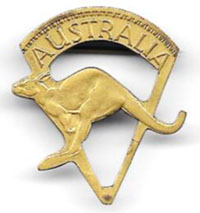
1). WWII victory pin. It is made from a bronze, brass plated Australian penny, 1938-1952. It is cutout in the shape of a V, for victory, showing the country name across the top with a kangaroo below. The kangaroo is an unofficial symbol of Australia and appears as an emblem on the Australian coat of arms. On the back is a bust of George VI and a pin for wearing.
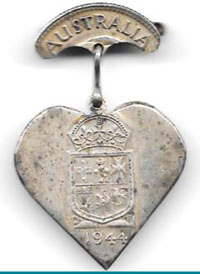
2). This pin is made from two silver Australian coins. The pin bar reads Australia and shows reeding across the top with a pin on the back and was cut from an Australian Shilling, 1938-1950. The suspended pendant was cut from a 1944 Australian Florin into the shape of a heart.
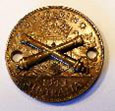
3). Bracelet coin. It was made from a silver, 1943-S Australian Florin. Soldered on the coin reverse are crossed cannons, the U.S. insignia for a field artillery unit. The two holes indicates it probably a center coin in a bracelet.
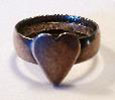
4). Hammered coin ring. This ring is made from a silver, Australian Florin, 1938-1945. Attached to the front of the ring is a silver heart. These rings were made by pounding or hammering the edge of a coin while rotating it. The coin got wider and smaller. The center of the coin is then cutout and the coin becomes a ring. The legends around the edges of the coin roll over when pounded and can be read on the inside of the ring. The heart was probably cut from the center plug cut out of the ring. The inscription on the inside of the ring reads, “GEORGIVS VI D:G:BR:OMN:REX F:D:IND:IMP//*FlO+RIN* Australia”.
The last piece is from a country that most people don’t realize played a role in WWII. It is the country of Iceland. Iceland was a neutral independent kingdom in union with Denmark. At the start of the war Britain offered assistance to Iceland seeking cooperation as an ally. Iceland reaffirmed is neutrality. Fearing Germany would occupy the country because of its strategic importance, Britain invaded Iceland on May 10, 1940. Britain and Canada occupied Iceland until June 16, 1941 when U.S. troops were sent there to relieve them with the U.S. staying there until the end of the war.
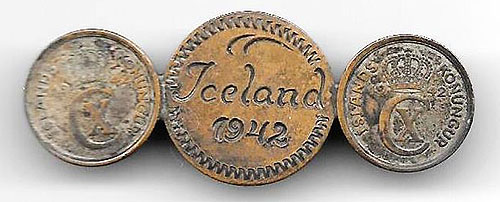
5). Three-Coin Brooch. This piece is made from three bronze Iceland coins; two, 1942, 1 Eyrir coins; one, 2 Aurar coin which is engraved “Iceland 1942”. A pin is mounted on the back.
While some of these pieces were carried, or worn by the servicemen who made them, many of the trench art coins, sometimes called sweetheart jewelry, were made with their girlfriend, wife or mother in mind and were sent home. Just maybe one of these pieces was brought home to the U.S. by one of the Australian war brides.
Have an interesting numismatic topic you’d like to share with your fellow NOW members?
Send your article to evan.pretzer@protonmail.com today!!!